Renewable Energy Market Size
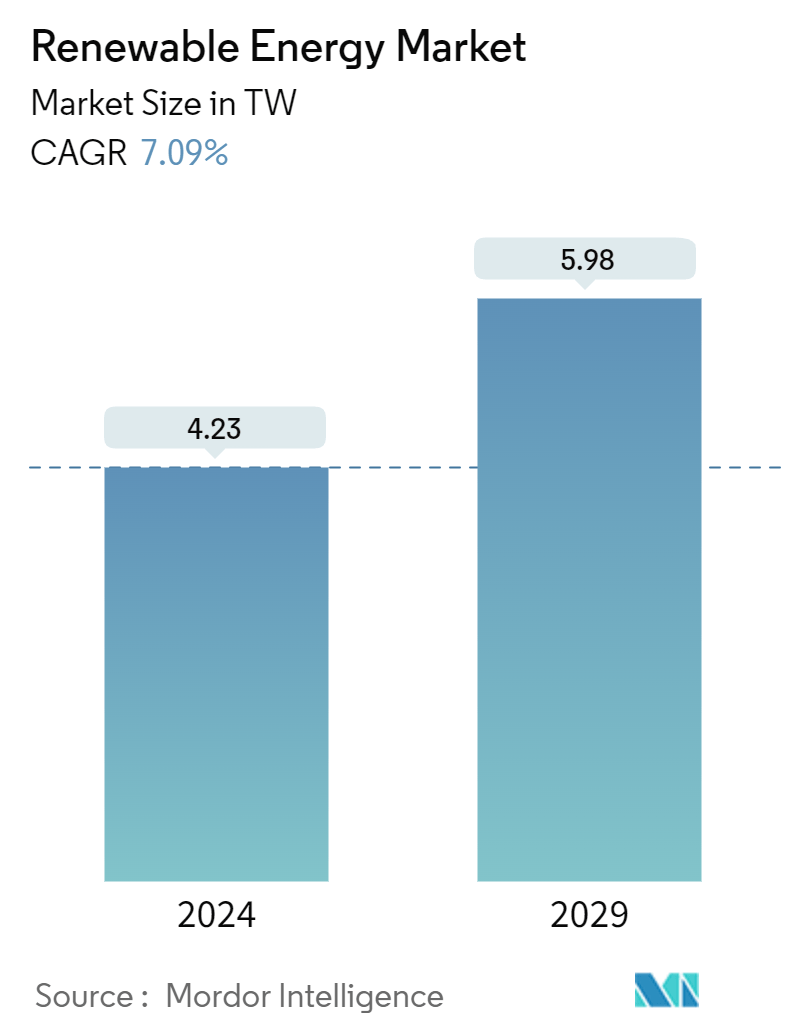
| Study Period | 2019 - 2029 |
| Base Year For Estimation | 2023 |
| CAGR (2024 - 2029) | 7.09 % |
| Fastest Growing Market | Asia Pacific |
| Largest Market | Asia Pacific |
| Market Concentration | Low |
Major Players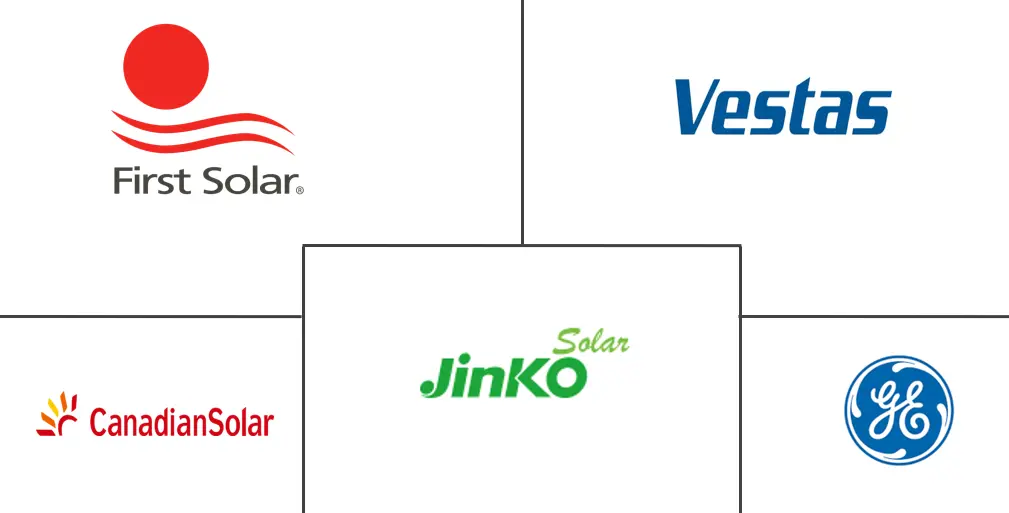
*Disclaimer: Major Players sorted in no particular order |
Renewable Energy Market Analysis
The Renewable Energy Market size is estimated at 4.23 TW in 2024, and is expected to reach 5.98 TW by 2029, at a CAGR of 7.09% during the forecast period (2024-2029).
- Over the long term, the major driving factors of the market are likely to be favorable government policies for renewable energy and declining prices of solar panels and wind turbine installations.
- However, the increasing penetration of natural gas for power generation is expected to hinder the renewable energy market’s growth.
- The ambitious renewable energy targets worldwide are anticipated to provide huge opportunities for the market studied.
- Asia-Pacific is expected to be the fastest-growing market during the forecast period, with major demand from China and India.
Renewable Energy Market Trends
Hydropower Segment is Expected to Dominate the Market during the Forecast Period
- Hydroelectric power (hydropower) is a renewable energy source where electrical power is derived from the energy of water moving from higher to lower elevations. Hydropower projects supply clean water for agriculture, homes, and businesses and mitigate the impacts of extreme weather events such as floods and drought.
- Hydropower is the single largest source of renewable electricity globally. In 2022, renewable electricity generation from hydropower accounted for nearly 41% of total renewable energy, the largest contribution from hydropower in global renewable-based electricity generation.
- According to the International Renewable Energy Agency, in 2022, the global hydropower installed capacity reached 1,393 gigawatts (GW), representing a rise of 2.19% compared to 2021. The hydropower installed capacity is expected to grow with the upcoming hydro projects and technological advancements.
- In August 2022, Natel Energy, created by MIT alumni siblings, developed hydropower systems that included fish-safe turbines and other features that imitate natural river conditions. Thus, with such eco-friendly developments, the hydropower segment's demand is expected to increase during the forecast period.
- In August 2022, the Government of India announced the development of two hydropower projects in Nepal, namely the West Seti Hydropower Project and the Seti River Hydropower Project. The total cost of these projects is expected to be around USD 2.4 billion.
- Thus, the hydropower segment is expected to dominate the market during the forecast period.
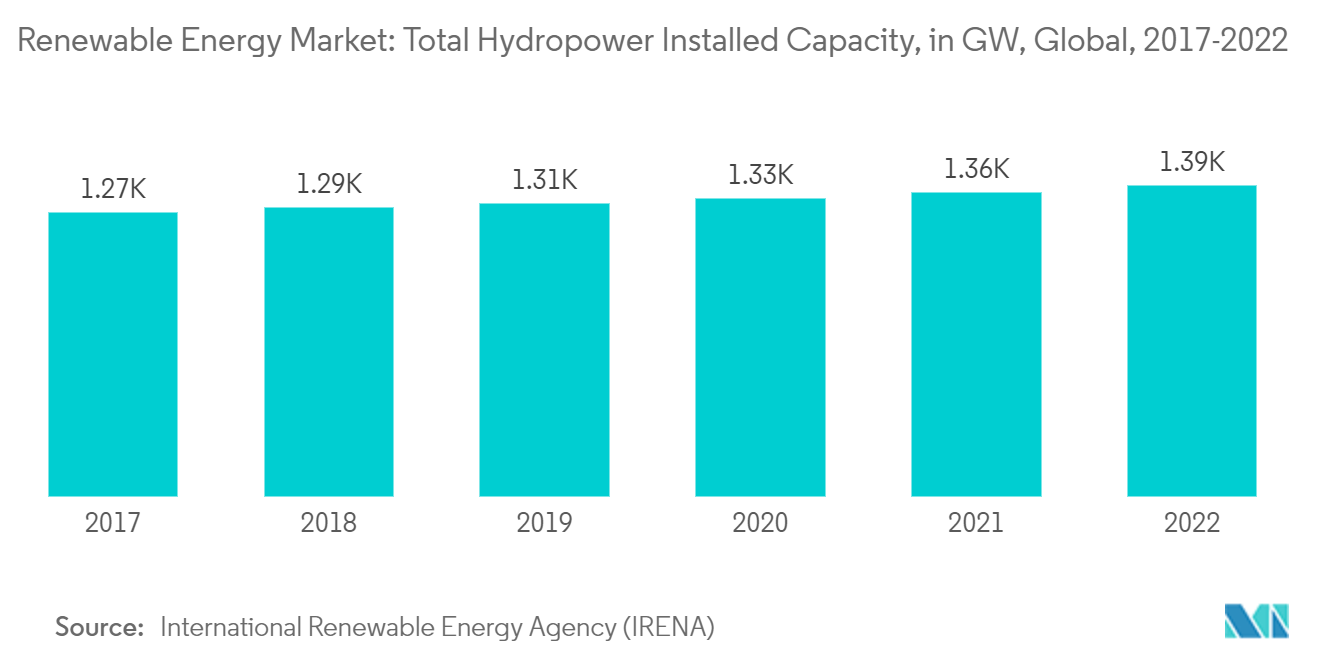
Asia-Pacific is Anticipated to Dominate the Market during the Forecast Period
- Asia-Pacific has dominated the renewable energy market over recent years, and it is likely to maintain its dominance during the forecast period.
- In 2022, China was the global leader in renewable energy deployment. The country's total renewable energy capacity reached 1,160.8 GW in 2022, representing an increase of approximately 13.4% compared to 2021. Hydropower, solar, and wind are the major renewable energy sources in the country.
- India's power demand increased significantly in line with its expanding economy and growing population. In 2022, the country generated 162.96 GW of hydropower, up from 147.12 GW in 2021.
- India has also become the world's third-largest power consumer after China and the United States. India's net power generation capacity increased significantly in the last decade, majorly from renewable energy sources, including large hydro sources.
- The Government of India had set a target of installing 175 GW of renewable energy capacity by FY 2022, including 100 GW from solar, 60 GW from wind, 10 GW from biopower, and 5 GW from small hydropower. The Indian Ministry for New and Renewable Energy expected an investment of USD 15 billion in renewable energy, electric vehicles, manufacturing of solar equipment, and green hydrogen in 2022.
- In January 2022, SJVN (Satluj Jal Vidyut Nigam Ltd) bagged a solar project of 125 MW in Uttar Pradesh through a bidding process held by the Uttar Pradesh New and Renewable Energy Development Agency (UPNEDA). The project includes a 75 MW grid-connected solar project in Jalaun and a 50 MW solar project in Kanpur Dehat districts.
- The Japanese government has also targeted reducing carbon emissions to 50% by 2030 and achieving carbon neutrality by 2050. In September 2022, Green Power Investment (GPI) chose GE Renewable Energy as the provider for the Fukaura Wind Farm in Fukaura Town, Nishi Tsugaru District, Aomori Prefecture, Japan. The project, which will include 19 units of GE's 4.2-117 onshore wind turbines, is GE's third in Japan.
- In December 2022, Amazon announced one of its first wind-solar hybrid projects in India with Vibrant Energy, a subsidiary of a portfolio company of Macquarie's Green Investment Group (GIG), India. The two projects represent 300 megawatts (MW) of renewable energy capacity, and the projects are located in Madhya Pradesh and Karnataka.
- Hence, such developments are expected to boost the Asia-Pacific renewable energy market during the forecast period.
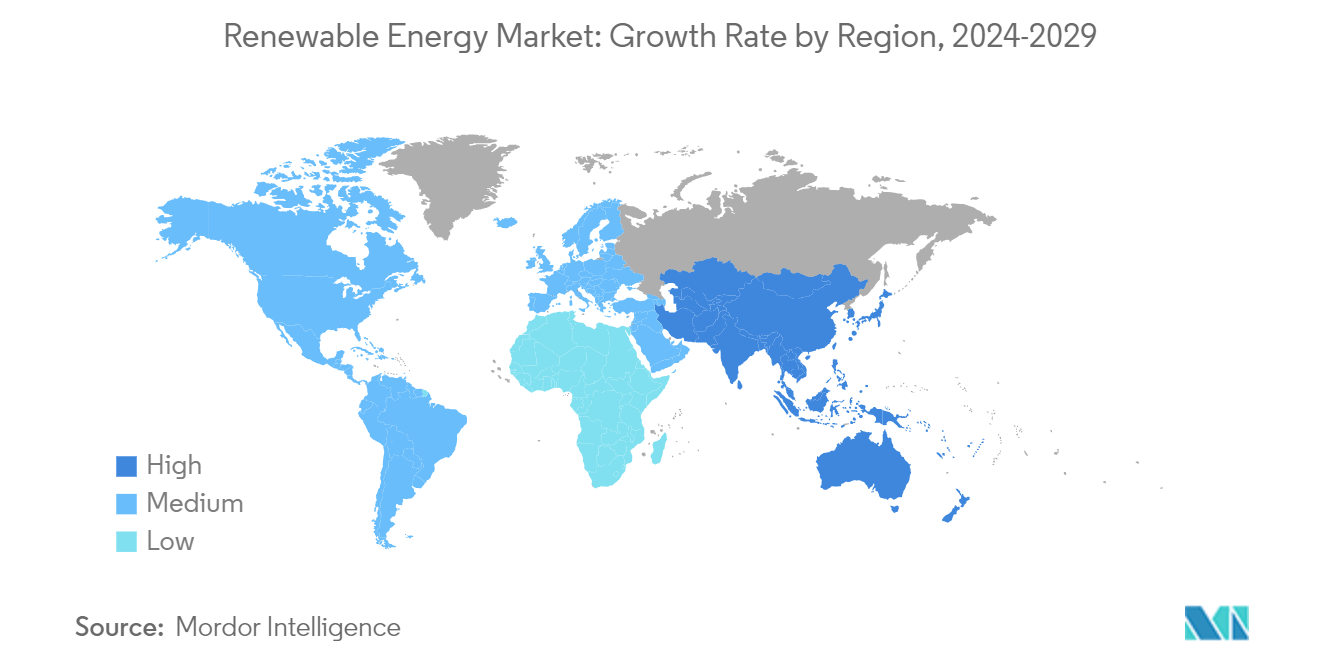
Renewable Energy Industry Overview
The renewable energy market is fragmented. Some of the major players in the market (in no particular order) are First Solar Inc., Vestas Wind Systems AS, Canadian Solar Inc., Jinko Solar Holding Co. Ltd, and General Electric Company.
Renewable Energy Market Leaders
-
Canadian Solar Inc.
-
General Electric Company
-
Vestas Wind Systems AS
-
First Solar Inc.
-
Jinko Solar Holding Co. Ltd
*Disclaimer: Major Players sorted in no particular order
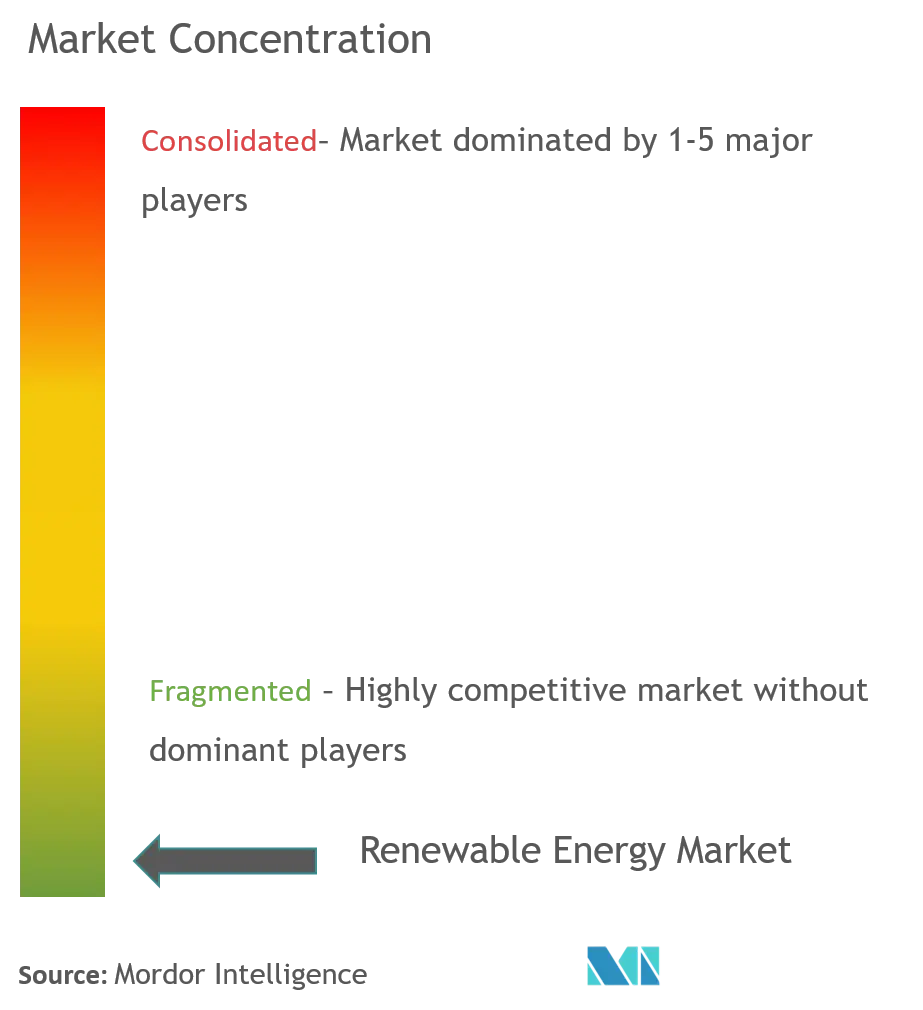
Renewable Energy Market News
- April 2023: ArcelorMittal announced that the company's Brazilian entity, ArcelorMittal Brazil, formed a joint venture with the Brazilian renewable energy company Casa dos Ventos to develop the 554 MW Babilonia wind power project. The project is expected to be developed at a cost of USD 800 million and will be located in the central region of Bahia, northeast Brazil. ArcelorMittal is anticipated to hold a 55% share in the joint venture, and the remaining share will be held by Casa dos Ventos.
- January 2023: Cepsa announced that it would build three new solar power projects in Castilla-La Mancha, Spain. The total capacity of the three solar energy farms is expected to be 400 MW. The projects are expected to be developed with an investment of USD 305 million in the towns of Campo de Criptana and Arenales de San Gregorio.
- May 2022: NJR Clean Energy Ventures (CEV) started construction on an 8.9-MW floating solar installation in Millburn, New Jersey, which is expected to be the largest floating array in the United States. The project uses a floating racking system, and 16,510 solar panels are expected to be installed on a reservoir located at the New Jersey American Water Canoe Brook Water Treatment Plant. The clean power generated by the array is anticipated to provide approximately 95% of the facility's annual power needs through a power purchase agreement with CEV.
Renewable Energy Market Report - Table of Contents
1. INTRODUCTION
- 1.1 Scope of the Study
- 1.2 Study Assumptions
2. EXECUTIVE SUMMARY
3. RESEARCH METHODOLOGY
4. MARKET OVERVIEW
- 4.1 Introduction
- 4.2 Renewable Energy Mix, 2023
- 4.3 Renewable Energy Installed Capacity and Forecast till 2029
- 4.4 Recent Trends and Developments
- 4.5 Government Policies and Regulations
-
4.6 Market Dynamics
- 4.6.1 Drivers
- 4.6.1.1 Favorable Government Policies for Renewable Energy
- 4.6.1.2 The Declining Price of Solar Panels and Wind Turbine Installations
- 4.6.1.3 Increasing Investments in Hydropower and Pumped Storage Hydropower Projects
- 4.6.1.4 Growing Emphasis on Geothermal Energy
- 4.6.2 Restraints
- 4.6.2.1 Increasing Penetration of Natural Gas for Power Generation
- 4.7 Supply Chain Analysis
-
4.8 Porter's Five Forces Analysis
- 4.8.1 Bargaining Power of Suppliers
- 4.8.2 Bargaining Power of Consumers
- 4.8.3 Threat of New Entrants
- 4.8.4 Threat of Substitutes Products and Services
- 4.8.5 Intensity of Competitive Rivalry
5. MARKET SEGMENTATION
-
5.1 Type
- 5.1.1 Solar
- 5.1.2 Wind
- 5.1.3 Hydro
- 5.1.4 Bioenergy
- 5.1.5 Other Types (Geothermal, Tidal, etc.)
-
5.2 Geography
- 5.2.1 North America
- 5.2.1.1 United States of America
- 5.2.1.2 Canada
- 5.2.1.3 Rest of the North America
- 5.2.2 Europe
- 5.2.2.1 United Kingdom
- 5.2.2.2 Germany
- 5.2.2.3 France
- 5.2.2.4 Spain
- 5.2.2.5 NORDIC
- 5.2.2.6 Turkey
- 5.2.2.7 Russia
- 5.2.2.8 Rest of the Europe
- 5.2.3 Asia-Pacific
- 5.2.3.1 China
- 5.2.3.2 India
- 5.2.3.3 Japan
- 5.2.3.4 Malaysia
- 5.2.3.5 Thailand
- 5.2.3.6 Indonesia
- 5.2.3.7 Vietnam
- 5.2.3.8 Rest of Asia-Pacific
- 5.2.4 Middle East and Africa
- 5.2.4.1 United Arab Emirates
- 5.2.4.2 Saudi Arabia
- 5.2.4.3 Egypt
- 5.2.4.4 Nigeria
- 5.2.4.5 South Africa
- 5.2.4.6 Qatar
- 5.2.4.7 Rest of the Middle East and Africa
- 5.2.5 South America
- 5.2.5.1 Brazil
- 5.2.5.2 Argentina
- 5.2.5.3 Colombia
- 5.2.5.4 Rest of the South America
6. COMPETITIVE LANDSCAPE
- 6.1 Mergers and Acquisitions, Joint Ventures, Collaborations, and Agreements
- 6.2 Strategies Adopted by Leading Players
-
6.3 Company Profiles
- 6.3.1 EPC Developers/Operators/Owners
- 6.3.1.1 Orsted AS
- 6.3.1.2 EDF SA
- 6.3.1.3 NextEra Energy Inc.
- 6.3.1.4 Duke Energy Corporation
- 6.3.1.5 Berkshire Hathway Energy
- 6.3.1.6 Acciona Energia SA
- 6.3.2 Equipment Suppliers
- 6.3.2.1 First Solar Inc.
- 6.3.2.2 Vestas Wind Systems AS
- 6.3.2.3 Canadian Solar Inc.
- 6.3.2.4 Jinko Solar Holding Co. Ltd
- 6.3.2.5 General Electric Company
- 6.3.2.6 Siemens Gamesa Renewable Energy SA
- *List Not Exhaustive
- 6.4 Market Ranking/Share (%) Analysis
7. MARKET OPPORTUNITIES AND FUTURE TRENDS
- 7.1 Ambitious Renewable Energy Targets across the World
Renewable Energy Industry Segmentation
Renewable energy is the energy collected from renewable resources such as sunlight, wind, water movement, and geothermal heat that are naturally replenished.
The global renewable energy market is segmented by type and geography. By type, the market is segmented into solar, wind, hydro, bioenergy, and other types. The report also covers the installed capacity and forecasts for the renewable energy market across major regions. For each segment, the market size and forecasts have been done based on installed capacity.
| Type | Solar | |
| Wind | ||
| Hydro | ||
| Bioenergy | ||
| Other Types (Geothermal, Tidal, etc.) | ||
| Geography | North America | United States of America |
| Canada | ||
| Rest of the North America | ||
| Geography | Europe | United Kingdom |
| Germany | ||
| France | ||
| Spain | ||
| NORDIC | ||
| Turkey | ||
| Russia | ||
| Rest of the Europe | ||
| Geography | Asia-Pacific | China |
| India | ||
| Japan | ||
| Malaysia | ||
| Thailand | ||
| Indonesia | ||
| Vietnam | ||
| Rest of Asia-Pacific | ||
| Geography | Middle East and Africa | United Arab Emirates |
| Saudi Arabia | ||
| Egypt | ||
| Nigeria | ||
| South Africa | ||
| Qatar | ||
| Rest of the Middle East and Africa | ||
| Geography | South America | Brazil |
| Argentina | ||
| Colombia | ||
| Rest of the South America |
Renewable Energy Market Research FAQs
How big is the Renewable Energy Market?
The Renewable Energy Market size is expected to reach 4.23 tw in 2024 and grow at a CAGR of 7.09% to reach 5.98 tw by 2029.
What is the current Renewable Energy Market size?
In 2024, the Renewable Energy Market size is expected to reach 4.23 tw.
Who are the key players in Renewable Energy Market?
Canadian Solar Inc., General Electric Company, Vestas Wind Systems AS, First Solar Inc. and Jinko Solar Holding Co. Ltd are the major companies operating in the Renewable Energy Market.
Which is the fastest growing region in Renewable Energy Market?
Asia Pacific is estimated to grow at the highest CAGR over the forecast period (2024-2029).
Which region has the biggest share in Renewable Energy Market?
In 2024, the Asia Pacific accounts for the largest market share in Renewable Energy Market.
What years does this Renewable Energy Market cover, and what was the market size in 2023?
In 2023, the Renewable Energy Market size was estimated at 3.93 TW. The report covers the Renewable Energy Market historical market size for years: 2019, 2020, 2021, 2022 and 2023. The report also forecasts the Renewable Energy Market size for years: 2024, 2025, 2026, 2027, 2028 and 2029.
Which segments are projected to grow the fastest in the Renewable Energy Market?
The residential segment, particularly the use of geothermal heat pumps, and the industrial segment are projected to grow rapidly in the Renewable Energy Market.
Renewable Energy Industry Report
The global renewable energy market is experiencing significant growth, driven by increasing adoption of various renewable energy sources. The market is segmented by type, including solar, wind, hydro, bioenergy, and other types such as geothermal and tidal. The Asia-Pacific region dominates the market share, with robust growth observed in North America, Europe, South America, and the Middle East and Africa as well.
Hydroelectric power remains a dominant segment, especially in developing economies, where it supports rural electrification and off-grid energy solutions. Solar energy is rapidly advancing as the fastest-growing segment, fueled by governmental initiatives to build smart cities and increase solar panel installations across residential, commercial, and industrial sectors.
The market's expansion is further propelled by rising environmental awareness, governmental incentives, and technological advancements that make renewable energy more accessible and cost-effective. Industry growth is supported by comprehensive industry analysis, providing key industry statistics and valuable industry information.
The industry outlook remains positive, with various industry reports highlighting the potential for continued market growth. Market data and market forecast indicate a promising future, with market leaders driving innovation and development. The market overview and market review underscore the dynamic shifts and trends within the renewable energy sector.
Market segmentation reveals diverse opportunities across different renewable energy types, contributing to the overall market value. Detailed report examples and report PDFs offer in-depth insights into the market trends and industry research. Research companies play a crucial role in providing accurate market predictions and industry sales data, ensuring stakeholders are well-informed.
In summary, the renewable energy market is poised for substantial growth, supported by favorable market conditions, technological advancements, and strong governmental support. The industry size and market growth reflect a vibrant and evolving sector, with a clear path towards a sustainable energy future.



